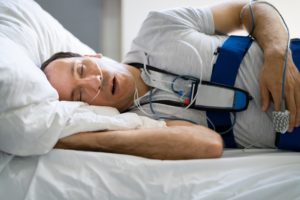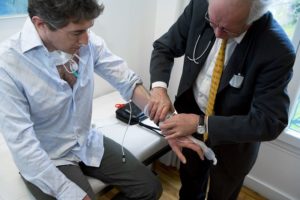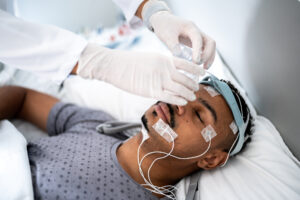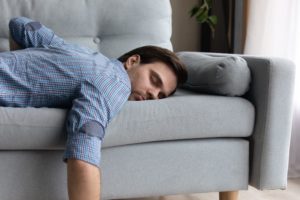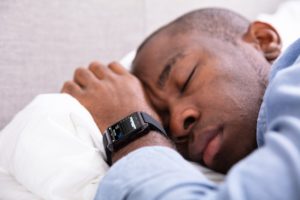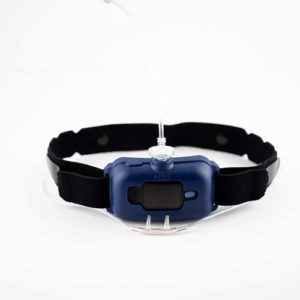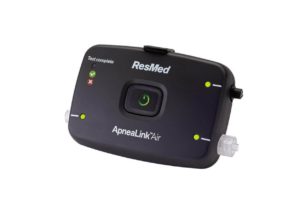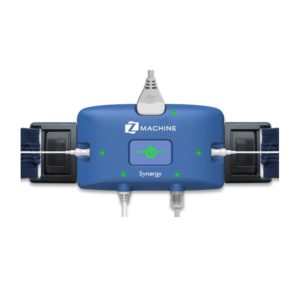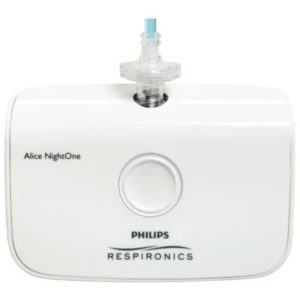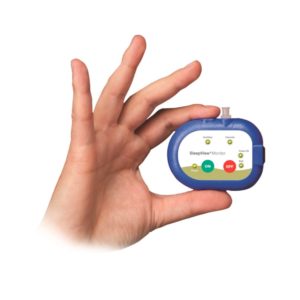Wakefulness After Sleep Onset
Waking up during the night is a common problem that can lead to feeling tired the next day and make it more difficult to function at home, work, and school. The impact of nighttime awakenings is made worse when a person has trouble falling back asleep. Lying awake for too long at night can be a sign of poor sleep quality.
Wakefulness after sleep onset (WASO) is a measurement that helps doctors and researchers evaluate the quality of a person’s sleep. Learning about WASO, as well as the causes and treatments of unwanted awakenings, may help people learn how to improve their sleep quality and achieve more restful sleep.
What Is Wakefulness After Sleep Onset (WASO)?
Wakefulness after sleep onset is a measurement used to assess a person’s sleep. It is the total number of minutes that a person is awake after having initially fallen asleep.
For example, if someone wakes up once during the night and is awake for 25 minutes, their WASO is 25 minutes. If they have two awakenings, one that lasts 10 minutes and another that lasts 5 minutes, their WASO is 15 minutes.
WASO is not a sleep issue or health condition. Instead, it is a metric that helps doctors and researchers understand a person’s sleep. By quantifying the extent of sleep interruptions, WASO can provide meaningful information about whether a person is staying asleep through the night or if their sleep is fragmented.
Some amount of WASO is normal, but too much time spent awake during the night can significantly reduce sleep quality .

Causes of WASO
Nighttime awakenings are caused by interruptions to sleep and can be due to many different factors. These include work or family, stress, the use of certain substances, sleep disorders, and a disruptive sleep environment.
Work, School, or Family
For some people, obligations related to their job, studies, or care of family members may make them susceptible to unwanted awakenings.
For example, people who work night shifts have been found to experience more sleep interruptions . College students, who often have irregular sleep patterns and poor sleep habits, are also prone to increased sleep fragmentation.
Caregiving responsibilities can also cause wakefulness after sleep onset. Parents of young children may have frequent sleep disruptions, and caregivers may have to wake up during the night to provide medication or otherwise attend to a loved one.
Stress
Stress and sleep quality have a bidirectional relationship . Stressful experiences can make it difficult to fall asleep and lead to nighttime awakenings, increasing a person’s wakefulness after sleep onset. Conversely, fragmented sleep can worsen mood and make it harder to cope with daytime stress.
Sleep-Disrupting Substances
A number of different substances may contribute to awakenings that increase WASO.
- Caffeine: The stimulant effect of caffeine can disrupt sleep.
- Alcohol: When the body metabolizes alcohol during sleep, it can interrupt normal sleep cycles and cause more awakenings.
- Nicotine: Most often found in tobacco products, nicotine is a stimulant that has been linked to an increased number of awakenings.
- Other medications: Many prescription drugs, over-the-counter medicines, and dietary supplements can interfere with sleep.
Sleep Disorders
Some sleep disorders cause fragmented sleep and increase WASO. For instance, people with insomnia often have difficulties sleeping through the night and may have trouble getting back to sleep after unwanted awakenings. As a result, they may spend a significant amount of time awake during the night.
Obstructive sleep apnea, a sleep disorder marked by disrupted breathing, can cause frequent nighttime awakenings. Restless leg syndrome, which involves a strong urge to move the limbs, can provoke sleep disturbances and difficulty returning to sleep. Sleep disruptions can also occur from sleep disorders that affect a person’s internal clock, known as their circadian rhythm.
Other Health Problems
Pain, disrupted breathing, and other symptoms of physical health conditions can cause a person to wake up during the night and increase WASO. Mental health problems, such as anxiety and depression, can also interfere with sleep. Some health issues also require waking during the night for device monitoring or to take medications.
Disruptive Sleep Environment
Many sleep interruptions are related to distractions or disturbances in the sleep environment. For example, excess light in the bedroom can make it easier to be woken up during the night , while bothersome noises can lead to shallower sleep and a greater number of awakenings. A bedroom temperature that is either too cold or too hot can also make it harder to stay asleep .
How Is WASO Measured?
WASO is measured in minutes and includes all time spent awake from the time when a person first falls asleep until they wake up and finish their sleep period.
There are a few methods to measure and calculate WASO.
- Polysomnography: This is a formal sleep study done in a clinic with special equipment to carefully track sleep time, sleep stages, awakenings, and other data. Polysomnography is considered to be the most accurate way to evaluate sleep , and diagnose many types of sleep disorders.
- Actigraphy: This type of sleep tracking uses a wearable device that collects information , including data related to body movements, which can then be used to estimate total time spent asleep and WASO. A benefit to actigraphy is that it can be done without having to go to a sleep clinic. When compared to a sleep study, actigraphy tends to underestimate WASO, but this may depend on the specific device used.
- Sleep diary: Another way of gathering data about sleep is by having a person keep a written record of their sleep, including any awakenings. While this can be a useful outline of a person’s sleep patterns, its reliance on self-reporting may cause data to be imprecise.
How Is WASO Used in Sleep Studies?
A sleep study may be used to diagnose certain sleep disorders, and calculating WASO can provide a standardized measurement to assess the amount of sleep fragmentation.
WASO is one factor that sleep experts may use to assess sleep quality. It is usually considered in conjunction with other measurements such as the total time spent asleep, the time it takes to fall asleep, the total number of awakenings, and the amount of disruptions in breathing.
This data can help determine if a person has a sleep disorder or another issue that may be affecting their sleep.
Understanding Sleep Efficiency
Sleep efficiency is another important measurement used to evaluate sleep. It is reported as a percentage and is generally calculated by dividing the total sleep time by the amount of time spent in bed. For example, if someone spends eight hours in bed and sleeps for 6 of those hours, their sleep efficiency is 75%.
Many people with sleep disorders have low levels of sleep efficiency, which means that they are awake for a significant portion of the time that they spend in bed. This is common in people with insomnia who toss and turn instead of sleeping.
Measuring a person’s sleep efficiency can help doctors identify sleep problems, recommend treatment, and monitor the effectiveness of interventions.
How Is Sleep Efficiency Different From WASO?
Both sleep efficiency and WASO are related to time spent awake in bed. Sleep efficiency accounts for the time it takes for a person to first fall asleep as well as time spent awake during the night. In contrast, WASO is only related to awakenings after initially falling asleep. Sleep efficiency is reported as a percentage, while WASO is measured in minutes.
How Is Sleep Latency Different From WASO?
Sleep latency is measured in minutes and describes the time it takes for a person to fall asleep after getting in bed and turning off the lights. This is different from WASO, which measures time spent awake after a person has fallen asleep.
How Does WASO Affect Day-to-Day Life?
High levels of wakefulness after sleep onset indicate a significant disruption in nightly sleep. Reductions in both the quantity and quality of sleep can cause numerous effects on day-to-day life, including impaired thinking and worsened mood.
Without enough quality sleep, people are more likely to wake up feeling unrefreshed. Sleep fragmentation may short-circuit the processes that enable sleep to be restorative, so some researchers believe that the effects of high levels of WASO are comparable to fewer hours of sleep.
Interrupted sleep can harm multiple types of thinking including memory, concentration, and decision-making. Studies suggest that it may also make people prone to stress and a depressed mood.
In addition to feeling more sluggish, people who have lots of unwanted awakenings may be more likely to experience negative physical effects. For example, one study found that fragmented sleep heightened sensitivity to multiple types of pain.
Insufficient sleep that occurs on a regular basis can also cause the accumulation of a sleep debt. Sleep debt grows each night a person loses sleep and can make the effects of poor sleep worse over time.
Are There Long-Term Consequences to WASO?
Increased time spent awake during the night can affect multiple systems in the body and may contribute to negative consequences for health and wellness over the long-term.
Over time, repeated sleep interruptions may increase the risk and severity of conditions like cardiovascular disease, obesity, gastrointestinal problems, and type 2 diabetes. Because of sleep’s ability to impact mood and stress, studies have found a link between disrupted sleep and potentially chronic mental health conditions like depression and anxiety.
Research has also found a link between sleep fragmentation and cognitive decline associated with Alzheimer’s dementia. Although more studies are needed to better understand this relationship, interrupted sleep is common in people with many kinds of neurological diseases.
What Treatments Can Help With WASO?
Small amounts of wakefulness after sleep onset is normal and may not detract from sleep quality. However, when around 20 minutes or more are spent awake during the night, it may be an indication that steps are warranted to improve sleep quality.
Treatment for high amounts of WASO can vary based on the cause of sleep interruptions. Many different approaches may be beneficial, and people with high levels of WASO should talk with a doctor or sleep specialist for tailored advice.
Addressing Underlying Issues
If a sleep disorder or a coexisting health issue is causing sleep disruptions, then treatment directed at that underlying problem may make it easier to stay asleep through the night.
Improving Sleep Hygiene
Sleep hygiene is a broad term that refers to a person’s sleep environment and their sleep-related routines. Some sleep hygiene improvements may help resolve excess WASO.
- Enhancing sleep habits: Healthy sleep habits may be able to eliminate causes of frequent nighttime awakenings. Practical steps such as following a consistent sleep schedule, reducing caffeine intake, and avoiding alcohol at night can promote better sleep.
- Optimizing the bedroom environment: A bedroom that is dark and quiet with a comfortable temperature can facilitate both falling asleep and avoiding disruptions during the night.
- Learning relaxation techniques: Being able to stay calm and quickly get back to sleep can keep nighttime awakenings short and prevent minutes of WASO from adding up. For example, deep breathing or meditation may help with relaxation and the transition back to sleep.
Cognitive Behavioral Therapy for Insomnia (CBT-I)
Cognitive behavioral therapy for insomnia, commonly called CBT-I, is a form of treatment for insomnia that involves addressing negative thoughts about sleep while developing concrete actions that can improve sleep patterns. Some research has found that CBT-I may reduce total WASO.
One component of CBT-I is called sleep restriction, which calculates how long a person should spend in bed based on their sleep efficiency. The goal of sleep restriction is to reduce time spent awake in bed, which can lead to stress and anxiety around sleep.
Medications
Some types of sleep medications can help people maintain sleep more consistently through the night. In some cases, drug formulations are intended to offer a longer-lasting dose that provides its sleep-promoting effects through the night. It is important for anyone experiencing sleep issues to consult with a doctor before taking a sleep aid.

Still have questions? Ask our community!
Join our Sleep Care Community — a trusted hub of sleep health professionals, product specialists, and people just like you. Whether you need expert sleep advice for your insomnia or you’re searching for the perfect mattress, we’ve got you covered. Get personalized guidance from the experts who know sleep best.
References
17 Sources
-
Shrivastava, D., Jung, S., Saadat, M., Sirohi, R., & Crewson, K. (2014). How to interpret the results of a sleep study. Journal of Community Hospital Internal Medicine Perspectives, 4(5), 24983.
https://pubmed.ncbi.nlm.nih.gov/25432643/ -
National Heart, Lung, and Blood Institute. (n.d.). Sleep deprivation and deficiency., Retrieved May 14, 2022, from
https://www.nhlbi.nih.gov/health-topics/sleep-deprivation-and-deficiency -
Boivin, D. B., & Boudreau, P. (2014). Impacts of shift work on sleep and circadian rhythms. Pathologie-biologie, 62(5), 292–301.
https://pubmed.ncbi.nlm.nih.gov/25246026/ -
Hershner, S. D., & Chervin, R. D. (2014). Causes and consequences of sleepiness among college students. Nature and Science of Sleep, 6, 73–84.
https://pubmed.ncbi.nlm.nih.gov/25018659/ -
Yap Y., Slavish D. C., Taylor D. J., Bei B., Wiley J. F. (2020). Bi-directional relations between stress and self-reported and actigraphy-assessed sleep: A daily intensive longitudinal study. Sleep, 43(3), zsz250.
https://pubmed.ncbi.nlm.nih.gov/31608395/ -
Cho, J. R., Joo, E. Y., Koo, D. L., & Hong, S. B. (2013). Let there be no light: The effect of bedside light on sleep quality and background electroencephalographic rhythms. Sleep Medicine, 14(12), 1422–1425.
https://pubmed.ncbi.nlm.nih.gov/24210607/ -
Okamoto-Mizuno, K., & Mizuno, K. (2012). Effects of thermal environment on sleep and circadian rhythm. Journal of Physiological Anthropology, 31(1), 14.
https://pubmed.ncbi.nlm.nih.gov/22738673/ -
Kramer, N. R. & Millman, R. P. (2021, November 5). Overview of polysomnography in adults. In S. M. Harding (Ed.). UpToDate.
https://www.uptodate.com/contents/overview-of-polysomnography-in-adults -
Thomas, S. J., & Gamble, K. (2022, April 6). Actigraphy in the evaluation of sleep disorders. In S. M. Harding (Ed.). UpToDate.
https://www.uptodate.com/contents/actigraphy-in-the-evaluation-of-sleep-disorders -
Reed, D. L., & Sacco, W. P. (2016). Measuring sleep efficiency: What should the denominator be? Journal of Clinical Sleep Medicine, 12(2), 263–266.
https://pubmed.ncbi.nlm.nih.gov/26194727/ -
Medic, G., Wille, M., & Hemels, M. E. (2017). Short- and long-term health consequences of sleep disruption. Nature and Science of Sleep, 9, 151–161.
https://pubmed.ncbi.nlm.nih.gov/28579842/ -
Van Someren, E. J., Cirelli, C., Dijk, D. J., Van Cauter, E., Schwartz, S., & Chee, M. W. (2015). Disrupted sleep: From molecules to cognition. The Journal of Neuroscience, 35(41), 13889–13895.
https://pubmed.ncbi.nlm.nih.gov/26468189/ -
Wilckens, K. A., Woo, S. G., Kirk, A. R., Erickson, K. I., & Wheeler, M. E. (2014). Role of sleep continuity and total sleep time in executive function across the adult lifespan. Psychology and aging, 29(3), 658–665.
https://pubmed.ncbi.nlm.nih.gov/25244484/ -
Iacovides, S., George, K., Kamerman, P., & Baker, F. C. (2017). Sleep fragmentation hypersensitizes healthy young women to deep and superficial experimental pain. The Journal of Pain, 18(7), 844–854.
https://pubmed.ncbi.nlm.nih.gov/28300651/ -
Lim, A. S., Kowgier, M., Yu, L., Buchman, A. S., & Bennett, D. A. (2013). Sleep Fragmentation and the Risk of Incident Alzheimer’s Disease and Cognitive Decline in Older Persons. Sleep, 36(7), 1027–1032.
https://pubmed.ncbi.nlm.nih.gov/23814339/ -
Abbott, S. M., & Videnovic, A. (2016). Chronic sleep disturbance and neural injury: links to neurodegenerative disease. Nature and science of sleep, 8, 55–61.
https://pubmed.ncbi.nlm.nih.gov/26869817/ -
Roehrs, T., & Roth, T. (2022, April 13). The effects of medications on sleep quality and sleep architecture. In Benca, R. (Ed.). UpToDate.
https://www.uptodate.com/contents/the-effects-of-medications-on-sleep-quality-and-sleep-architecture


